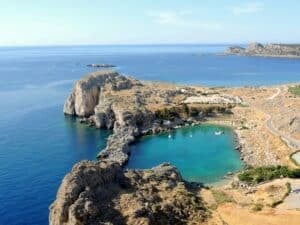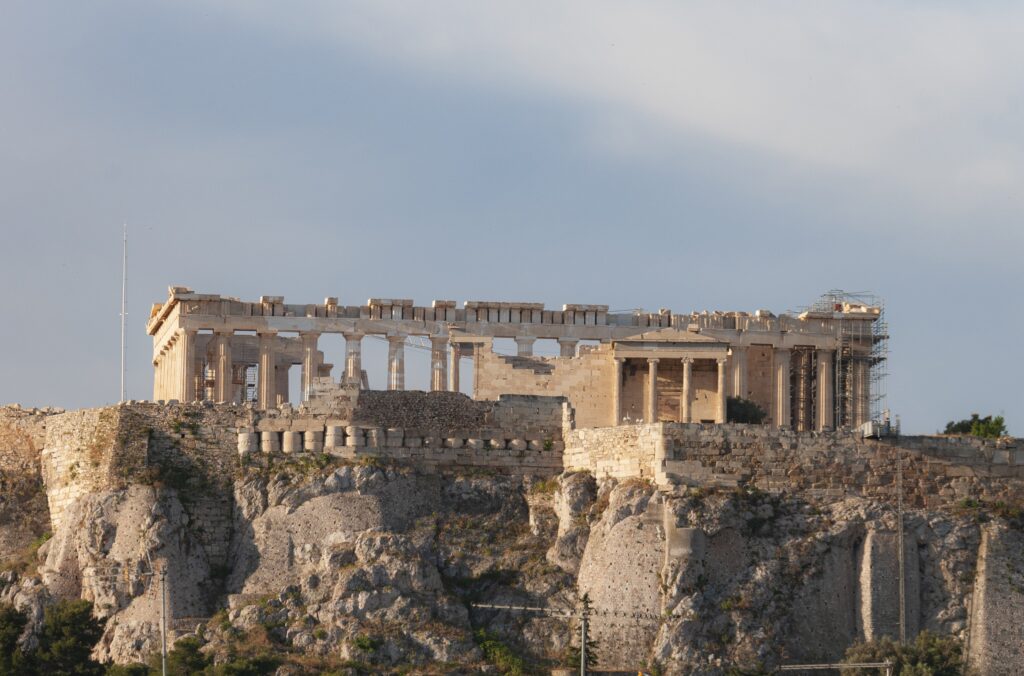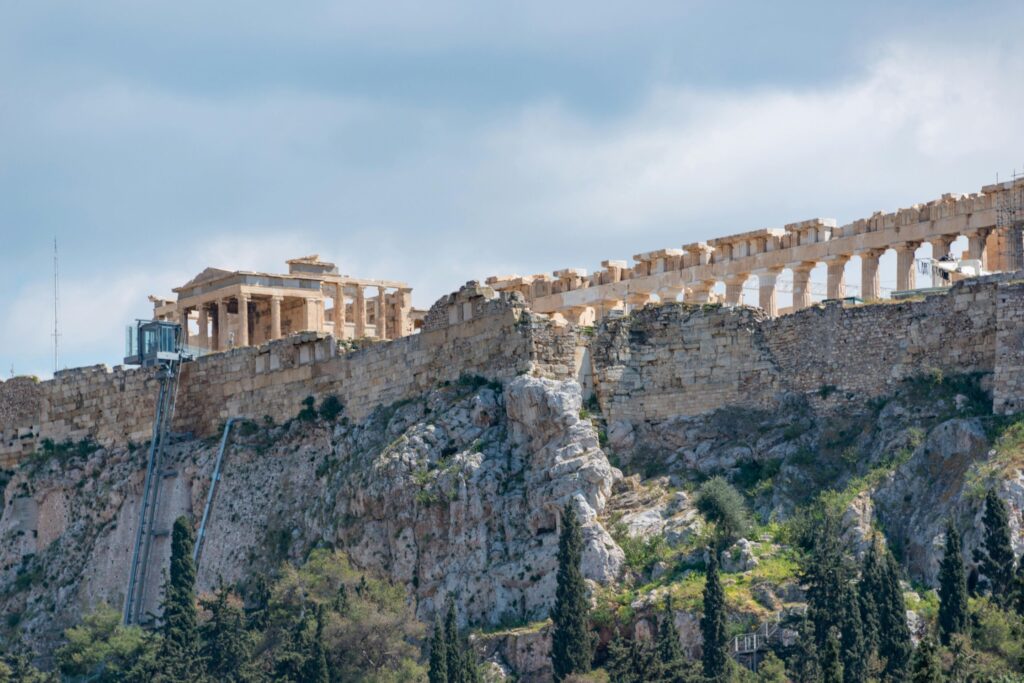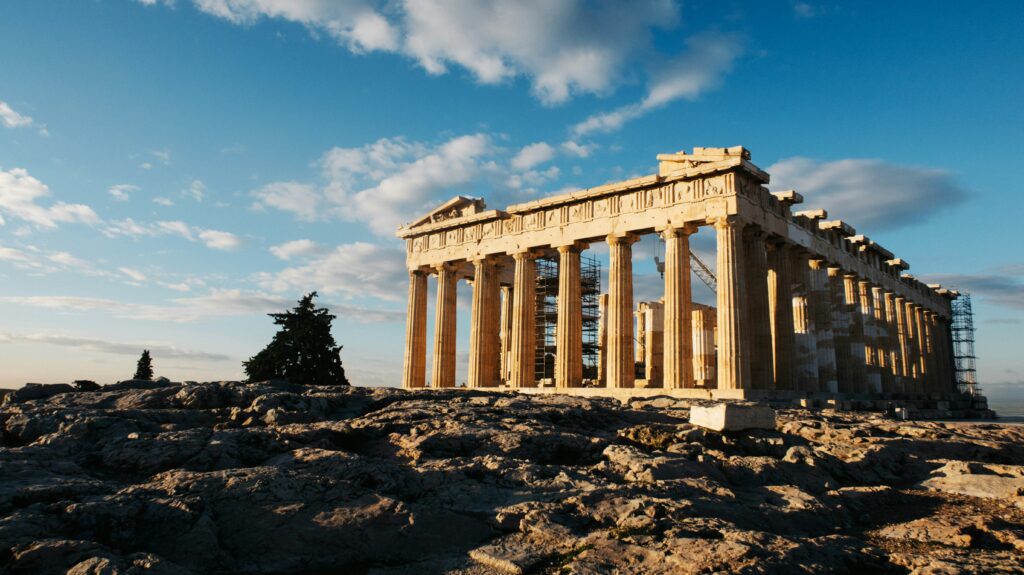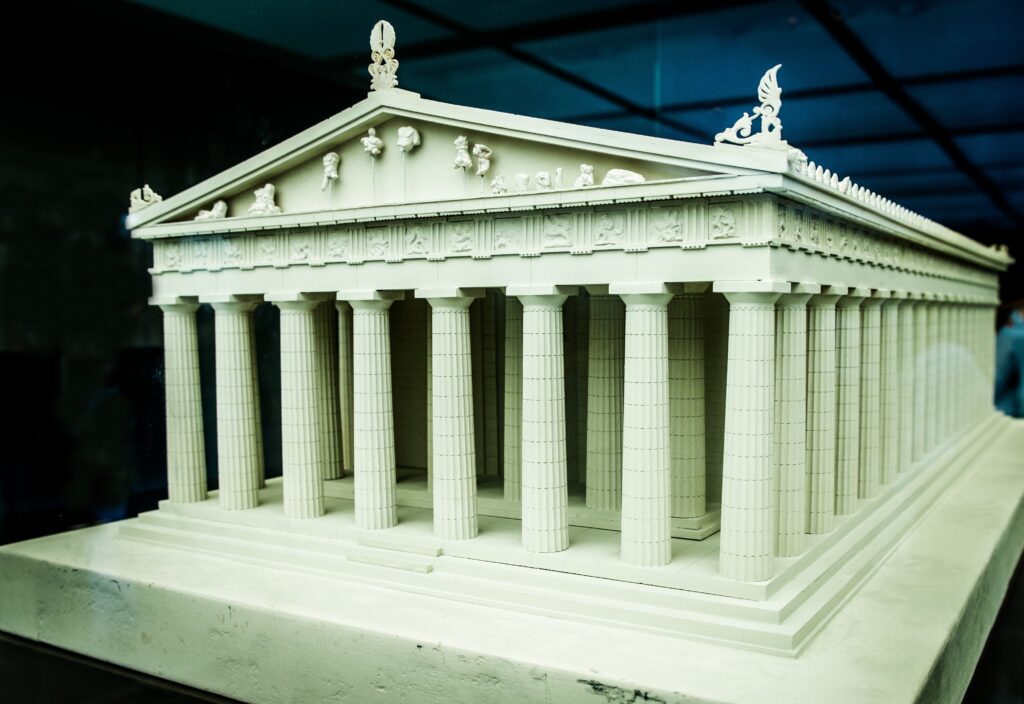The Parthenon, Jewel of Ancient Athens
The Parthenon, located on the Acropolis in Athens, is the jewel of ancient Greek architecture. Dedicated to the goddess Athena, it symbolizes the grandeur of Greek civilization. Built in the 5th century BC, it embodies the faith, culture and power of Athens.
An architectural masterpiece, it is distinguished by its perfect proportions and sculptures, created under the direction of the sculptor Phidias. Today, the Parthenon remains a living symbol of Athenian democracy, attracting visitors from all over the world.
The story of an ancient temple turned icon
Building the Parthenon
The Athenians built the Parthenon in the 5th century BC to honor their patron goddess, Athena. Pericles, their great strategist, oversaw the project, while sculptor Phidias directed the decorative work. Construction began in 447 BC and took around 15 years, at the height of Athens’ greatness. The challenges were many, including the Peloponnesian War and the difficult conditions of working with marble. The temple symbolized the power and prosperity of Athens at its height.
Milestones in its history
Over the centuries, the Parthenon has undergone various transformations. Initially a temple dedicated to Athena, it was transformed into a Christian church in the 6th century, then into a mosque under the Ottoman Empire in the 15th century. In 1687, an explosion caused by Venetian gunfire partially destroyed the building. The Parthenon was also disfigured by the removal of the marble by Lord Elgin in the early 19th century. Today, the Parthenon remains a symbol of Athens and Western culture, and its status as a historic monument is protected.
The Parthenon, Architecture Beyond the Centuries
Architectural features
The Parthenon features a Doric style, characterized by simple, solid columns. This style, with its refined design, is perfectly suited to the temple dedicated to Athena, goddess of war and wisdom. The columns are made of pentelic marble, a brilliant white material prized for its beauty and durability. The building measures approximately 31 metres wide and 69 metres long. It is surrounded by 46 columns, 8 at the front and 17 on the sides.
Technical innovations
The Parthenon introduced architectural innovations to improve the temple’s aesthetics and stability. For example, the columns are not perfectly straight, but slightly curved to compensate for the effect of optical distortion. In addition, the stylobate (the top of the temple steps) is slightly curved to compensate for optical illusions, making the building more harmonious. These adjustments create an illusion of perfection, accentuating the temple’s beauty.
The importance of sculptures
The sculptures of the Parthenon, created by Phidias and his workshop, are among the most famous of Antiquity. They included friezes depicting mythological scenes and divine figures, such as those adorning the pediment and the continuous frieze. The Parthenon Marbles, notably the group sculpted by Phidias, depict scenes from the Trojan War and the Olympian gods. These sculptures were not only decorative, but also symbolized the ideals of Athens, in particular the superiority of the gods and the heroism of the Athenians.
The Evolution of an Ancient Monument through the Ages
The Parthenon was not always the imposing monument we know today. Over the centuries, it has undergone major transformations and destruction. Its history reflects the evolution of Greece through the ages, marked by conflict, invasion and religious change.
Destructions and Transformations
After its conversion into a Christian church in the 5ᵉ century, the Parthenon underwent its first transformation. During the Ottoman occupation in the 15ᵉ century, the temple became a mosque. In 1687, an explosion severely damaged the structure, when the Venetians bombarded Athens and hit the Parthenon. At the time, the Parthenon served as an ammunition depot for the Ottoman army.
The Looting of Sculptures
The Parthenon marbles were partially removed by Lord Elgin in the early 19ᵉ century. He transported them to London, where they are currently on display at the British Museum. This highly controversial action led to heated debate. Greece is still demanding their return, as it considers the sculptures an integral part of its cultural heritage. The looting of the Parthenon marbles remains one of the world’s greatest heritage scandals.
Athena's Mythology at the Heart of the Parthenon
The Parthenon is dedicated to Athena, goddess of wisdom and war. This temple embodies the link between Greek mythology and the greatness of Athens. According to mythology, Athena was born from the head of Zeus, after he had swallowed his first wife, Metis. This divine birth symbolizes wisdom and strategy, essential qualities for the Athenians.
The temple housed a gigantic statue of Athena Parthenos, created by the sculptor Phidias. Made of gold and ivory, the statue represented the goddess in all her majesty. She was the heart of the Parthenon, symbolizing the protection of Athens. The goddess was seen as the city’s protector, guiding its citizens in war and peace.
The myths surrounding Athena were essential to the temple. For example, during the Panathenaeum, a festival in honor of Athena, the citizens of Athens offered sacrifices to honor the goddess. These myths shaped the Parthenon, making it more than just a place of worship: a symbol of Athens’ power and identity.
Political and religious life around the Parthenon in Athens
A Temple at the Heart of Athens' Political and Cultural Life
The Athenians built the Parthenon not only as a temple to Athena, but also as a symbol of the power of Athens. It served as a political, cultural and religious center. The temple housed important treasures, such as offerings and sacred objects, used in public ceremonies. Indeed, the Parthenon functioned as a gathering place for Athenian citizens, reinforcing the unity of the city.
The Panathenaeums: Celebrations in honor of Athena
he Athenians celebrated the Panathenaeum, the great religious festival in honor of Athena. These festivities included processions, sacrifices and sporting competitions, including chariot races. The temple was at the heart of these celebrations, uniting the population around a single cult. These events were not only religious, but also political, celebrating the greatness of Athens and its role as a leader in the Greek world.
The Role of Religious Ceremonies in Athenian Society
Ceremonies around the Parthenon served to reinforce Athens’ identity and prestige among other Greek cities. They were a means of demonstrating the city’s power and the favor of the gods. They also served to educate the population, reminding them of their common heritage and the values of the city.
The Parthenon Marbles and their Cultural Heritage
The Parthenon marbles, sculpted by Phidias, represent a masterpiece of ancient Greek art. They decorate the temple’s friezes and pediments, illustrating mythological and historical scenes.
At the beginning of the 19th century, Lord Elgin removed a large number of these marbles from the Parthenon. He transported them to England, stirring up controversy. Greece has been demanding their return for years, arguing that they are part of its cultural heritage. The dispute remains a subject of international debate.
The marbles are now on display at the British Museum, while Greece continues to press for their return. The debate raises questions about the restitution of cultural works and their importance to the world’s heritage.
The Parthenon marbles are much more than mere works of art. They symbolize the aspiration to preserve and share humanity’s cultural treasures. Their return would enable Greece to revive the entire legacy of the Parthenon, a symbol of ancient culture.
Curiosities and Secrets of Ancient Architecture
Beyond its architectural beauty, the Parthenon is full of intriguing stories and little-known facts. Here are some fascinating facts to discover:
The mysterious "optics" of the Parthenon columns
The optics refer to the subtle curves of the columns and stylobate. They are not straight, but slightly curved to correct the optical distortions caused by perspective. This ingenious technique demonstrates the mastery of ancient Greek architecture.
The number of sculptures still on the site
Today, some of the original sculptures remain on the site, such as the friezes and pediments. Lord Elgin removed many of these sculptures in the early 19th century. Others are preserved in museums, notably the British Museum.
Recent discoveries in the Parthenon excavations
Archaeological excavations continue to reveal new elements, such as fragments of statues and inscriptions, which help us to better understand the structure and function of the Parthenon in antiquity.
The first excavation of the Parthenon
One of the first to seriously excavate the site was Greek archaeologist Kyriakos Pittakis in the early 19th century. He uncovered several important elements and contributed to the preservation of the Parthenon at a time when the building was in poor condition. Interest in the Parthenon then grew considerably in the 19th century, with international interest in Greek archaeology.
The Parthenon as Christian temple and mosque
The Parthenon, dedicated to the goddess Athena, became a Christian church in the 6th century. Later, after the Ottoman conquest in the 15th century, it was transformed into a mosque. This transformation modified the Parthenon, adding minarets and Christian iconographic elements. It also suffered considerable damage from battles and attacks.
The role of marble in Western art
The sculptures of the Parthenon have had a profound influence on Western art. After their extraction by Lord Elgin, the marbles were exhibited in London. They became a benchmark for 19th-century artists. The marbles inspired many artists, including Renaissance sculptors and those of the neoclassical movement.
The temple used as an arsenal
During the Greek War of Independence against the Ottoman Empire, the Ottomans used the Parthenon as a military arsenal. In 1687, a Venetian bombardment hit the Parthenon while it was being used as a gunpowder depot. This caused a massive explosion, destroying part of the structure.
The Parthenon friezes and their aesthetic influence
The Parthenon frieze is a sculptural masterpiece. In addition to its beauty, it is a testament to the technical and artistic skills of ancient Greek sculptors. The friezes depict a religious procession, representing the greatness and dignity of the Athenian people. These friezes have profoundly influenced the visual arts in the history of art.
The Parthenon faces conservation challenges
Efforts to preserve the Parthenon are multiplying. For decades, Greek and international experts have been working tirelessly to maintain the monument’s integrity. Restoration, though complex, is essential to counter the wear and tear of time and the damage caused by weathering, pollution and war.
The contributions of specialists in various fields (archaeology, engineering, materials conservation) have enabled the temple to be stabilized. However, the restoration process is not without controversy. The methods used, such as replacing certain stones with copies, have sometimes given rise to debate.
The challenges of conservation are manifold. Modern interventions have to be constantly balanced against the monument’s authenticity. In addition, the temperature and humidity, not least due to the masses of visitors, complicate the task. The Parthenon, fragile but magnificent, requires constant care.
The Parthenon and Tourism: An Impact to Manage
Tourism plays a crucial role in the preservation of the Parthenon. Every year, millions of visitors come to admire this ancient wonder. Tourism generates income, but it also puts pressure on the monument. As a result, restrictions are placed on the number of visitors, and certain areas are restricted.
Today, tours are better structured. Guides, information panels and modern technology help to manage the crowds while informing visitors about the history of the site. In addition, the Greek authorities monitor the air quality and stability of the building, ensuring its long-term preservation.
The Parthenon's Impact on Modern Art and Architecture
The Parthenon has had a lasting influence on modern art and architecture. Its impeccable design and sculptural elements have inspired architects and artists down the centuries. This section explores how its influence lives on.
Influence on classical and modern architecture
The architecture of the Parthenon, particularly its simplicity and majesty, left its mark on the architects of later centuries. Famous architects such as Karl Friedrich Schinkel used its principles in their designs. Schinkel adopted the Doric style and the use of columns for many government buildings in Europe in the 19th century.
Impact on government buildings
Government buildings around the world are inspired by the Parthenon. Its influence can be seen in the design of the U.S. Capitol in Washington D.C., as well as other neoclassical monuments. The imposing columns and sculpted friezes of these buildings recall the Parthenon and its timeless aesthetic.
The Parthenon and Renaissance art
During the Renaissance, artists such as Michelangelo and Raphael incorporated elements of the Parthenon into their works. The friezes and sculptures inspired famous frescoes and sculptures, reinforcing the link between ancient Greek and Western art. This dialogue between Antiquity and the Renaissance has ensured that the beauty of the Parthenon has stood the test of time.
